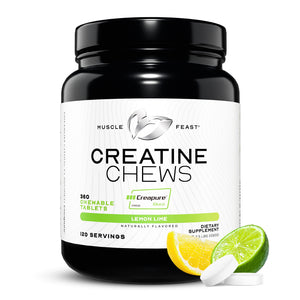1. Introduction
Every movement we make depends on one molecule: ATP (adenosine triphosphate), the body’s main source of usable energy. The problem is that muscles store only a few seconds worth of ATP. When you sprint, lift or train hard, those reserves run out almost instantly.
This is where phosphocreatine (PCr) comes in. Think of PCr as your body’s emergency energy buffer. When ATP levels start to fall, PCr quickly donates a phosphate group to ADP, restoring ATP and keeping your muscles contracting at full strength.
Research shows that creatine supplementation increases the amount of PCr stored in muscle, improving:
- Anaerobic power (short bursts like sprints or HIIT)
- Strength and resistance-training performance
- Recovery between sets and high-intensity efforts
Some users notice mild side effects such as water retention or cramping, which are temporary and related to fluid shifts inside muscle cells. Clinically, creatine has also been studied for muscle atrophy, heart disease, and other conditions involving low cellular energy.
2. Creatine Synthesis
Your body can make creatine naturally.
- In the kidneys, the amino acids glycine and arginine combine to form guanidinoacetate.
- In the liver, that compound is converted into creatine by adding a methyl group from methionine.
This methylation step is crucial it stabilizes the molecule and allows it to travel safely through the bloodstream.
Once in the blood, creatine enters muscle through a sodium-dependent transporter (CreaT1). This transporter uses sodium’s movement to “pull” creatine into the cell, often carrying water along with it. That’s why muscles sometimes look or feel fuller after supplementation
3. Creatine Supplementation
There are two main ways to increase muscle creatine:
- Loading phase: About 20 grams per day for 5-7 days quickly saturates the muscles.
- Steady phase: 2-3 grams daily will reach the same levels, just over a few weeks.
Typical muscle concentrations:
- Normal: 110-140 mmol/kg dry muscle
- Fully saturated: ~160 mmol/kg
People who already eat a lot of meat or have larger muscle mass may respond less because their levels are closer to full saturation. Vegetarians or those under heavy training stress tend to see bigger improvements.
4. Creatine Transport
After supplementation, muscles generally hold creatine at around 160 mmol/kg, which is the upper limit. Any extra is excreted as creatinine in urine.
Those with low baseline levels like vegetarians or smaller athletes usually gain more noticeable strength and recovery benefits. Once the muscle “tank” is full, additional creatine doesn’t add further effect.
5. Water Balance and Hydration
When creatine enters the cell with sodium, water follows. This creates a mild swelling of the muscle cell, increasing hydration and giving a firmer or “fuller” appearance.
Some people experience cramps or mild heat intolerance during early loading because of electrolyte shifts. Drinking enough water and using moderate daily doses usually prevents this.
Creatine naturally converts to creatinine about 2 grams per day which the kidneys filter out. Slightly higher creatinine levels on lab tests are normal and harmless in healthy individuals.
6. Mitochondria and Energy Recycling
Once phosphocreatine is used up, it must be rebuilt. This happens inside the mitochondria, where mitochondrial creatine kinase (Mi-CK) re-charges creatine using energy from oxidative phosphorylation.
Here’s how the cycle works:
- At the muscle fiber: PCr donates a phosphate group to ADP, forming ATP for contraction.
- After use: Creatine diffuses back into mitochondria.
- Inside mitochondria: Mi-CK re-phosphorylates creatine, turning it back into PCr.
This cycle runs continuously, allowing muscles to maintain steady ATP levels even under high demand.
7. Muscle Bioenergetics
Phosphocreatine acts like an energy buffer. By recycling ADP back into ATP, it prevents the buildup of ADP and AMP, which can slow contractions and cause fatigue.
Normally, when ADP accumulates, the myokinase reaction converts it to ATP + AMP but AMP eventually breaks down to ammonia, wasting valuable energy molecules.
Creatine reduces this loss, helping muscles work harder with less metabolic “waste.”
Higher PCr stores also mean muscles recover faster between sets because ATP can be rebuilt more quickly.
8. Phosphocreatine and Cell Protection
Beyond fueling energy, PCr helps stabilize muscle cell membranes. Its unique structure both water- and fat-loving lets it interact with cell membranes, making them more resilient under stress.
In the heart, intravenous PCr has been shown to protect against energy loss during low oxygen (ischemia), reduce irregular heartbeats, and improve contraction strength.
For athletes, this stabilization may reduce soreness and prevent small amounts of cellular leakage after intense exercise.
9. The Phosphocreatine Shuttle
Energy must move efficiently from where it’s made (mitochondria) to where it’s used (muscle fibers).
The phosphocreatine shuttle makes that possible:
- Mitochondria create PCr.
- PCr diffuses to the myofibrils and donates its phosphate to ADP to form ATP.
- The used creatine then returns to mitochondria to be recharged.
This shuttle ensures a constant supply of ATP at the exact location where it’s needed, especially during quick, explosive movements.
10. Conclusion
Creatine and phosphocreatine form a powerful system that keeps your muscles energized and resilient. Supplementing with creatine boosts these natural stores, improving strength, recovery, and high-intensity performance.
Phosphocreatine itself (used intravenously in clinical settings) shows additional benefits like membrane protection and heart support but oral creatine remains the most practical and effective form for daily use.
While researchers continue to study hydration, sex differences, and long-term outcomes, creatine stands as one of the most well-understood and reliable performance supplements available today.
- Conrad RN
References
Clark JF. Creatine and Phosphocreatine: A Review of Their Use in Exercise and Sport. Journal of Athletic Training.1997; 32(1): 45–51. PMCID: PMC1318941.








